Description
Deep Magic of Giants and the Northlands!
Beneath the auroras is a savage land of frenzied barbarians, doom-laden heroes, flinty dwarves, and giants who dare to wage war against the gods themselves. The magic of the north is deep and ancient, and its practitioners are masters of the secret powers of the runes.
Deep Magic: Rune Magic brings the secrets of rune magic into your 5th Edition campaign, with 24 pages featuring:
- New Rune Knowledge and Rune Mastery feats
- 25 runes that grant wisdom and power over time, fire, water, wealth, and more
- 5 new rune rituals, including Curse of the Wild Moon, Scourge of Hateful Nettles, and Tyr’s Peace
- 32 new or updated rune spells, including curse of Boreas, Loki’s gift, snowblind stare, and Wotan’s rede
- New magic items, monsters, and more!
The ravens gather, and the wolves howl. Ready yourself, wizard: whatever emerges from the cold, dark forests this day will learn the power of rune magic!

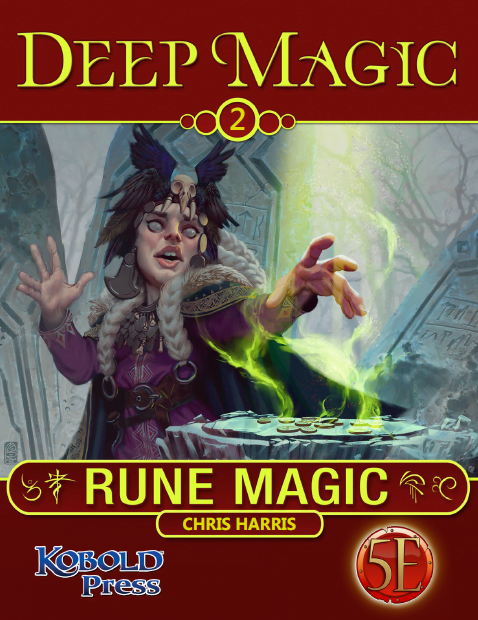
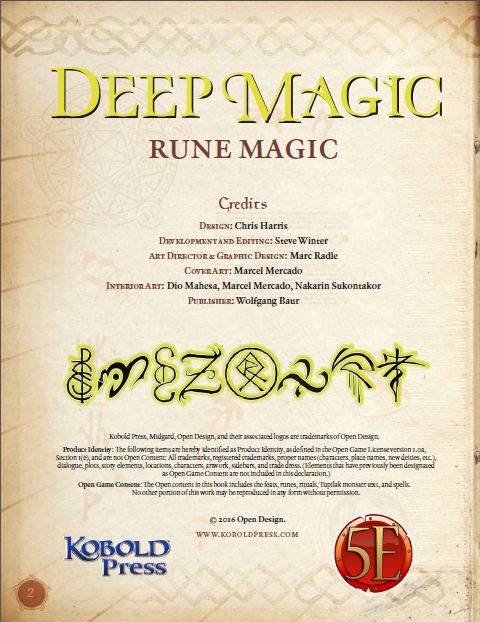
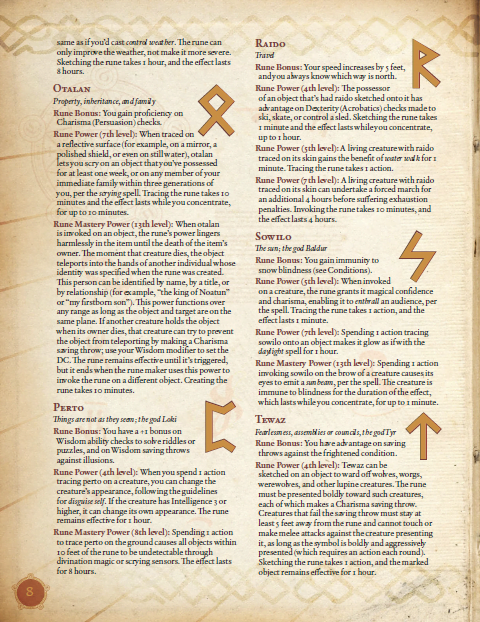
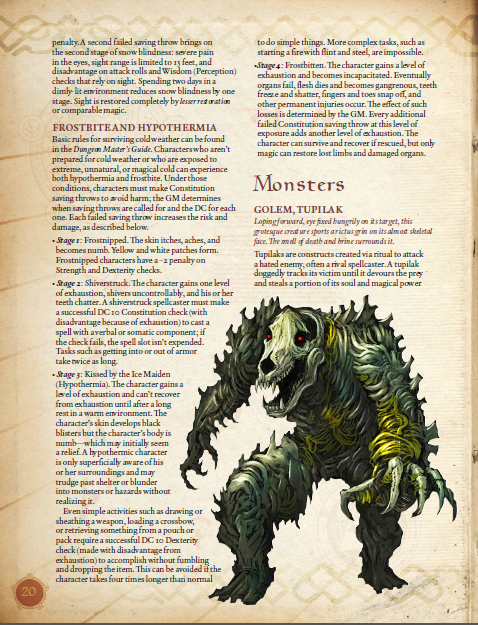
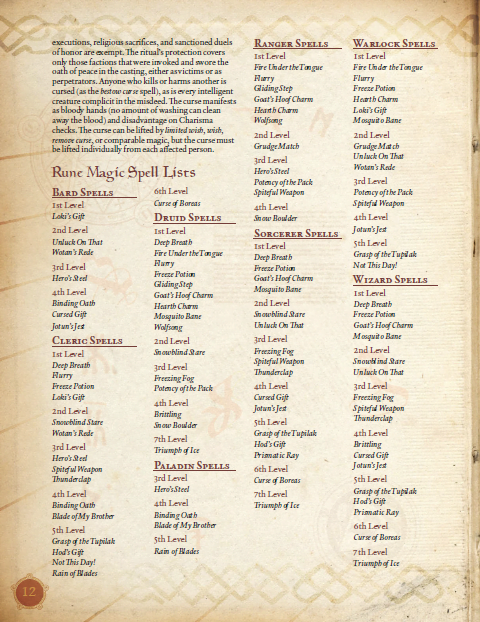

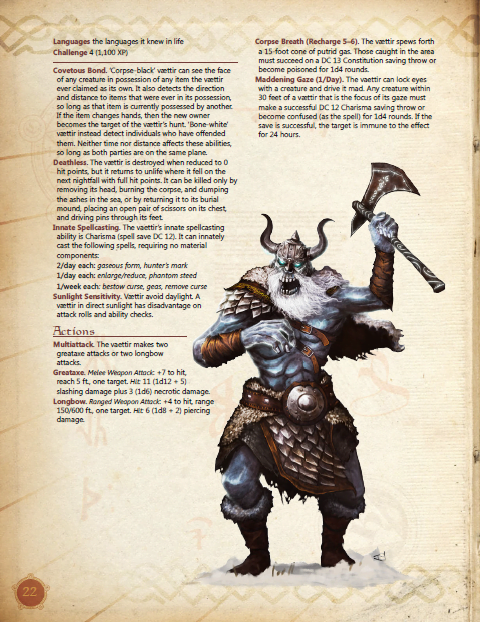

Megan Robertson –
The assumption is made that you have a reasonable grasp of what runes and rune magic are, and already know that they are associated with people from cold northern realms (think Vikings in the real world), it dives straight in by explaining that you need a Rune Knowledge feat to use them at all, and a Rune Mastery feat to develop your skills. Thereafter, though, the contents are excellent with a lot of material to get your teeth into.
First up, the Rune Knowledge and Rune Mastery feats are given in full detail, then there’s a fascinating run-through of the runes themselves. This makes it clear that learning rune magic is a slow and painstaking process: when you learn Rune Knowledge you get to choose just TWO runes which you can use (and Rune Mastery enables to use a single rune you know at a higher level)… fortunately you can take both feats multiple times. For each rune, you get a specific bonus just because you know it, and then you learn the effects of tracing that rune (standard and mastery levels of knowledge) – and there’s an image as well so you know the shape to trace.
Next, there are several rune rituals to perform. These are associated with specific runes and there’s the rather cryptic comment that once you know the appropriate rune, you can eventually master the appropriate ritual – no indication of how long that takes or what you have to do to master it. The rituals themselves are full of Norse flavour, fitting that mindset.
Then there are rune magic spell lists (for all spell-using classes) followed by the detailed spell descriptions themselves. Many again have Nordic themes or deal with cold, curses, and similar concepts, although there is no real connection with runes themselves otherwise. They do fit in well with the general themes of the magic in this book, however, so could work well for spell-casters of appropriate origin or as spells used by a character who also has the rune-using feats in his build.
These are followed by a couple of neat magic items. The nithing rod is rather fun, it’s a kind of landmine you set for an enemy whom you’d like to curse. Once you have created it (and you have to know the individual, it’s not a general purpose weapon) you set it up someplace you think your enemy is likely to pass, and when he does it not only casts bestow curse on him, it keeps on doing so until he fails his saving throw! They also curse anyone who tries to tidy them away, although then they only cast the curse once.
There’s also a couple of conditions – snow blindness and hypothermia – and a couple of monsters which relate to the rituals earlier, which summon them. It helps if you have the full statistics of whatever is conjured up, after all!
Overall, this is a nice selection of material to bring a northern flavour into your game – it’s good on the crunchy bits, the actual effects you can create using your rune magic, but a little short on the flavour that would put it all into context.
Lorathorn –
First of all, let me start by saying that Kobold Press always puts out some amazing books in terms of layout, art, and presentation. though I did not put on my editor hat, I didn’t notice any grammatical errors, and the book itself is beautiful. It is a shame that the book is so short, or I would want to order it as a print item. I hope to see a compilation in the future that might come in a hardback perhaps?
Now onto the meat of the review. This is a very interesting book, and has some strong implications for magic through feat selection. Given the precedent for magic through feats (PHB feats: Magic Initiatve, and Ritual Caster), these spells seem on par, giving a very different and curiously intricate venue for either giving magic to classes that do not have it, or bolstering those that do. I would presume that a magic using class would be less likely to take them, and fighters more likely, given their abundance of feat options. This is exciting, and makes me want to make some kind of Runic Viking fighter.
The runes themselves all seem well done, and somewhat narrow in scope. This focus makes them good for cherry picking, especially as some have a shallow but wide utility, making the rune selection less about bonuses and more about a character’s personality.
The runic mastery abilities, learned through another feat, are far more powerful, and represent a path to power that requires great investment on the part of the player. The structure of this power acquisition is ingenious, and shows a lot of forethought and great design acumen.
There are a bevy of new spells as well that complement the runic powers in theme. I think I have the most issues with this section, and the spells themselves are oddly balanced, usually not being powerful enough, or having effects that don’t make sense (e.g. extending the range of a spell using 5 ft increments per spell level, or having a 4th level spell to break objects that is on par with the 2nd level spell shatter). Some spells are so specialized that they seem aimed at NPCs or very specialized casters (which makes classes like Bards, Rangers, and Sorcerers unlikely to take them). Many of the 1st level effects seem almost meant for cantrip effects, and are not on par with the 5th edition design model of having 1st level spells be more effective than their 3rd edition counterparts. It is almost as if these spells were directly moved from their Pathfinder version, and as I have not had a chance to look at the Pathfinder verison of Deep Magic, I can only assume this to be the case.
Many of the spells are good and well balanced by 5th edition standards, but enough of them are not that it seems like this product could use a revision specific to the spells.
The magic items are rather interesting and well done by my reckoning. I would love to use them in my campaigns.
The conditions are great, as I have felt like 5th edition’s current conditions list is lacking for certain situations. I love the concept of hypothermia as it deviates from just defaulting to exhaustion, and makes the cold really matter more than just being a throwaway occasional Constitution saving throw. The cold should matter, and this condition makes it very prominently dangerous.
Two monsters are included, one a reprint from Tome of Beasts (the Vaettir) and one is new (the Tupilak Golem). The Vaettir is included as it is relevant to the spells and runes from this book, and the Tupilak golem is a welcome addition and a very neat monster that I can’t wait to use. Both are done very well, and make masterful use of the rules.
Overall, I am very happy with this book, though I am hopeful to see if the issue with the spells may be addressed in the future. As it is, I can use them, but I intend to modify them perhaps for my purposes. This is a solid book, and you can’t really beat the price. If you like the concept of rune magic, this is an excellent resource. If you like things Norse and cold, this is also an excellent resource. Don’t cast off on your viking longship without it!
I give this product 4 stars.
Endzeitgeist –
An Endzeitgeist.com review
The second installment of Kobold Press’ Deep Magic-series clocks in at 24 pages, 1 page front cover, 1 page editorial, 1 page SRD, 1 page advertisement, leaving us with 20 pages of content, so let’s take a look!
Rune magic works differently from other magic types in its PFRPG-version – and so it makes sense to use a different system in 5e as well: There is a feat called Rune Knowledge, which nets knowledge of 2 runes of the player’s choice, granting the respective rune bonuses. Additionally, once per day, you can invoke a rune’s rune power, provided you meet the prerequisite, for several runes have several rune powers, with progressively better ones being unlocked later. The feat may be taken additional times, with each additional time granting access to more runes and their powers. As a nitpick, I think rune powers should not be tied to days, but long rest intervals, but that is a mostly cosmetic gripe.
There is a follow-up feat, analogue to PFRPG: Rune Mastery. This feat requires the previous feat and grants you access to one rune mastery effect. As a minor complaint: While rune mastery abilities have prerequisite levels, the feat, unlike its brother, does not mention the requirement of meeting that prerequisite, which is relevant since some rune mastery powers don’t unlock at 8th level, but rather at 13th or as late as 15th level, for example. Again, I think tying them to rest intervals instead of enforcing a hard daily cap would have made sense for rune mastery powers as well.
A rune’s save throw DC is dependent on the rune employed – if it forces a Cha-save, for example, it employs Cha as governing attribute for the save, which follows the default 8 + rune maker’s ability bonus + rune maker’s proficiency bonus. In another cosmetic hiccup that will not influence the final verdict, usually you list the proficiency bonus first. Anyways, the runes are based on the FuÞark and basic meanings are noted.
Yes, meanings. Plural. The runes were not necessarily used as classic letters, but also have a very significant symbolic meaning…which is btw. the reason I almost get an aneurysm whenever someone wears some piece of gaudy jewelry that uses runes as a letter-substitution. Ahem. Anyways, their benefits run a pretty wide array of different benefits – the goal, from a design perspective, is obviously based on establishing breadth, rather than depth: While many runes provide minor bonuses to a certain skill (rune bonuses), the runes are more remarkable for the breadth they provide: Take the very first one, Algiz: It allows you to create elk horn wands, which represent a new magic item that allows the wielder to generate saving throw bonuses for a brief time and enhances dispelling. As a rune power, the user may scratch it on a wall or structure, granting bonuses to saves and effects versus sleep or unconsciousness that last for 8 hours.
Many of these runes are not only balanced by the steep cost of two feats, but also by their cultural context, hard-wired into the very design of the respective runes, with several explicitly stating that they unleash their power only versus foes of the Aesir, who have wrung their control from the well of Mimir. (Insert long-winded and at this time redundant digression about Norse mythology you have by now hear x times from me here…)
This contextualizes them well and makes them feel infused with the culture…and also provides a rationale for their design-philosophy deviating slightly from what you usually receive in 5e. In short: They behave like their own engine, which is something I applaud, considering that, at least as far as my experiences are concerned, it is said sub-engines that make certain class choices more popular than others in 5e. It is also why I am not complaining about colons instead of full stops in the formatting of the rune abilities.
I digress. I should also mention that several runes have multiple rune mastery powers, though only one can be invoked for each rune, with the benefits ranging from local plant growth to communing with the dead, making an item teleport out of a creature’s hand once it dies…there is some serious narrative potential here, as several runes practically beg both players and GMs to embark on a collective narrative experience. Only one rune got a bit lost: Poor Raido does not have a rune mastery power, though its brief water walking and forced march enhancing capabilities make for a nice basic rune. One more thing that will make this pdf instantly more compelling to quite a few of my readers out there, a fact that very much makes this a viable purchase even if you’re not interested in the concept of runes:
This installment of deep magic introduces the snowblindness condition and the 4-stage frostbite/hypothermia-engine, which ties into the amazing exhaustion mechanics of 5e (seriously, I love them!). These alone may be enough to justify getting this book, I kid you not. I am a big fan of environmental/wilderness gaming and 5e’s base engine does a nice job at portraying a rigorous adventuring life in regular climates, but in the more extreme zones, it needed this expansion. Seriously: Massive kudos!
These conditions, btw., do not exist in their own little universe – instead, the runes and new spells make nice use of them and their effects. Speaking of spells: perhaps my favorite blending of runes and spells is that there are rune rituals that follow pretty much the format of rituals, but which can only be learned by the rune associated with them: Whether you wish to call forth the vaettir (whose stats are reprinted from the ToB) to transforming creatures into lycanthropes…the applications are fun. Now *personally*, I do believe that Tyr’s Peace should rather be Forseti’s Peace, considering that Tyr’s area or expertise was primarily judgment/justice in regards to warfare, while the ritual penalizes bloodshed in general, not just among previous combatants…but one could argue for Tyr just as well…so yeah, I’m good with these.
I am NOT good with the new and updated spells herein. We can find instances where spells refer to caster level based damage progression sans requiring the usual increase in spell slot, first level spells that are basically on cantrip-level…or e.g. prismatic ray, which does not work analogue to its 5e-brothers and instead works closer to a pathfinder-spell. Not cool. Which is a pity, for concept-wise, quite a few of these are amazing.
Beyond aforementioned wand, we get the nithing pole wondrous item, which promises a curse to the named person that dares approach it. Two thumbs up! Now, I already mentioned the Vaettir, but one of my favorites from Northlands, the tupilak golem at challenge 4 can also be found within this supplement…and its 5e-iteration is surprisingly brutal for its challenge. I mean it. Love this guy…but if you encounter it…run and do your legwork, otherwise you’ll be in for pain!!
Conclusion:
Editing and formatting are very good, I did not notice too grievous hiccups. Layout adheres to Kobold Press’ beautiful 2-column full-color standard and the pdf sports several truly gorgeous full-color artworks, some of which are original, while the vaettir, for example, will be familiar to owners of the ToB. The pdf comes with bookmarks, but not to individual runes or spells.
Chris Harris delivers regarding rune magic: I really, really like how he has converted the engine; the magic is suffused by a sense of the primal and fantastic, it breathes mythology and its generally conservative, but narrative-wise relevant bonuses and tricks are a boon and just make for great story-telling. I really like them. I ADORE the hypothermia-engine and snowblindness as well and the critters would similarly receive two thumbs up from me. While I have nitpicked quite a bit in the beginning, if that was all, I’d frankly slap, gladly, my seal on this. I like how this behaves as an engine, I like the wealth of options it provides and how it can be used to run gritty campaigns – I could see myself running a game sans regular magic, with only the runes in a really gritty setting.
But, oh, but. The spells. They represent cool, evocative concepts and tie n well with the flavor presented…but their balance and mechanics are off; they feel like very basic in their conversion and balance-wise, could have used a bit closer comparisons to the existent spells. They, in short, tarnish what would otherwise receive my highest accolades. Hence, my final verdict can “only” clock in at 4 stars, though I still HIGHLY recommend getting this if you plan on playing any adventure in the frigid landscapes of the North.
Endzeitgeist out.
Thilo Graf –
An Endzeitgeist.com review of the revised version
The second installment of Kobold Press’ Deep Magic-series clocks in at 24 pages, 1 page front cover, 1 page editorial, 1 page SRD, 1 page advertisement, leaving us with 20 pages of content, so let’s take a look!
Rune magic works differently from other magic types in its PFRPG-version – and so it makes sense to use a different system in 5e as well: There is a feat called Rune Knowledge, which nets knowledge of 2 runes of the player’s choice, granting the respective rune bonuses. Additionally, once per day, you can invoke a rune’s rune power, provided you meet the prerequisite, for several runes have several rune powers, with progressively better ones being unlocked later. The feat may be taken additional times, with each additional time granting access to more runes and their powers. As a nitpick, I think rune powers should not be tied to days, but long rest intervals, but that is a mostly cosmetic gripe.
There is a follow-up feat, analogue to PFRPG: Rune Mastery. This feat requires the previous feat and grants you access to one rune mastery effect. As a minor complaint: While rune mastery abilities have prerequisite levels, the feat, unlike its brother, does not mention the requirement of meeting that prerequisite, which is relevant since some rune mastery powers don’t unlock at 8th level, but rather at 13th or as late as 15th level, for example. Again, I think tying them to rest intervals instead of enforcing a hard daily cap would have made sense for rune mastery powers as well.
A rune’s save throw DC is dependent on the rune employed – if it forces a Cha-save, for example, it employs Cha as governing attribute for the save, which follows the default 8 + rune maker’s ability bonus + rune maker’s proficiency bonus. In another cosmetic hiccup that will not influence the final verdict, usually you list the proficiency bonus first. Anyways, the runes are based on the FuÞark and basic meanings are noted.
Yes, meanings. Plural. The runes were not necessarily used as classic letters, but also have a very significant symbolic meaning…which is btw. the reason I almost get an aneurysm whenever someone wears some piece of gaudy jewelry that uses runes as a letter-substitution. Ahem. Anyways, their benefits run a pretty wide array of different benefits – the goal, from a design perspective, is obviously based on establishing breadth, rather than depth: While many runes provide minor bonuses to a certain skill (rune bonuses), the runes are more remarkable for the breadth they provide: Take the very first one, Algiz: It allows you to create elk horn wands, which represent a new magic item that allows the wielder to generate saving throw bonuses for a brief time and enhances dispelling. As a rune power, the user may scratch it on a wall or structure, granting bonuses to saves and effects versus sleep or unconsciousness that last for 8 hours.
Many of these runes are not only balanced by the steep cost of two feats, but also by their cultural context, hard-wired into the very design of the respective runes, with several explicitly stating that they unleash their power only versus foes of the Aesir, who have wrung their control from the well of Mimir. (Insert long-winded and at this time redundant digression about Norse mythology you have by now hear x times from me here…)
This contextualizes them well and makes them feel infused with the culture…and also provides a rationale for their design-philosophy deviating slightly from what you usually receive in 5e. In short: They behave like their own engine, which is something I applaud, considering that, at least as far as my experiences are concerned, it is said sub-engines that make certain class choices more popular than others in 5e. It is also why I am not complaining about colons instead of full stops in the formatting of the rune abilities.
I digress. I should also mention that several runes have multiple rune mastery powers, though only one can be invoked for each rune, with the benefits ranging from local plant growth to communing with the dead, making an item teleport out of a creature’s hand once it dies…there is some serious narrative potential here, as several runes practically beg both players and GMs to embark on a collective narrative experience. Only one rune got a bit lost: Poor Raido does not have a rune mastery power, though its brief water walking and forced march enhancing capabilities make for a nice basic rune. One more thing that will make this pdf instantly more compelling to quite a few of my readers out there, a fact that very much makes this a viable purchase even if you’re not interested in the concept of runes:
This installment of deep magic introduces the snowblindness condition and the 4-stage frostbite/hypothermia-engine, which ties into the amazing exhaustion mechanics of 5e (seriously, I love them!). These alone may be enough to justify getting this book, I kid you not. I am a big fan of environmental/wilderness gaming and 5e’s base engine does a nice job at portraying a rigorous adventuring life in regular climates, but in the more extreme zones, it needed this expansion. Seriously: Massive kudos!
These conditions, btw., do not exist in their own little universe – instead, the runes and new spells make nice use of them and their effects. Speaking of spells: perhaps my favorite blending of runes and spells is that there are rune rituals that follow pretty much the format of rituals, but which can only be learned by the rune associated with them: Whether you wish to call forth the vaettir (whose stats are reprinted from the ToB) to transforming creatures into lycanthropes…the applications are fun. Now *personally*, I do believe that Tyr’s Peace should rather be Forseti’s Peace, considering that Tyr’s area or expertise was primarily judgment/justice in regards to warfare, while the ritual penalizes bloodshed in general, not just among previous combatants…but one could argue for Tyr just as well…so yeah, I’m good with these.
I am NOT good with all of the new and updated spells herein.While not all spells have been streamlined (fire under the tongue is still pitiful for a 1st level spell…which hurts, considering the cool visuals!), the revised version has been improved in that regard. Still, not as cool as the rune section, which is a pity, for concept-wise, quite a few of these are amazing.
Beyond aforementioned wand, we get the nithing pole wondrous item, which promises a curse to the named person that dares approach it. Two thumbs up! Now, I already mentioned the Vaettir, but one of my favorites from Northlands, the tupilak golem at challenge 4 can also be found within this supplement…and its 5e-iteration is surprisingly brutal for its challenge. I mean it. Love this guy…but if you encounter it…run and do your legwork, otherwise you’ll be in for pain!!
Conclusion:
Editing and formatting are very good, I did not notice too grievous hiccups. Layout adheres to Kobold Press’ beautiful 2-column full-color standard and the pdf sports several truly gorgeous full-color artworks, some of which are original, while the vaettir, for example, will be familiar to owners of the ToB. The pdf comes with bookmarks, but not to individual runes or spells.
Chris Harris delivers regarding rune magic: I really, really like how he has converted the engine; the magic is suffused by a sense of the primal and fantastic, it breathes mythology and its generally conservative, but narrative-wise relevant bonuses and tricks are a boon and just make for great story-telling. I really like them. I ADORE the hypothermia-engine and snowblindness as well and the critters would similarly receive two thumbs up from me. While I have nitpicked quite a bit in the beginning, if that was all, I’d frankly slap, gladly, my seal on this. I like how this behaves as an engine, I like the wealth of options it provides and how it can be used to run gritty campaigns – I could see myself running a game sans regular magic, with only the runes in a really gritty setting.
The spells, while improved, are still not perfect examples of their craft, though they are theme-wise strong. Hence, my final verdict can “only” clock in at EDIT: 4.5 stars, and I feel I can’t round up for this one, though I still HIGHLY recommend getting this if you plan on playing any adventure in the frigid landscapes of the North.
Endzeitgeist out.